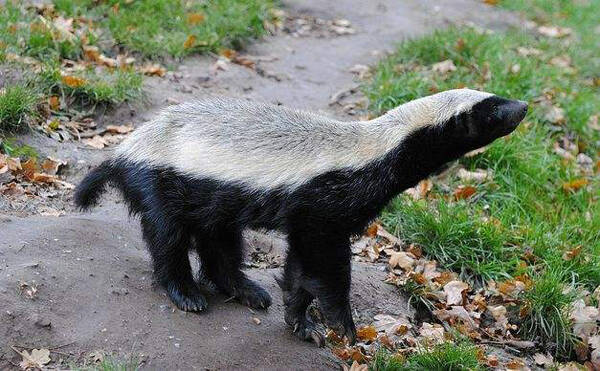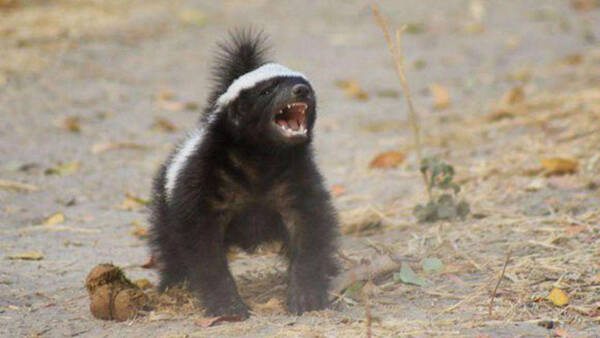Mellivora capensis
IUCN
LCBasic Information
Scientific classification
- name:Mellivora capensis
- Scientific Name:Mellivora capensis, Honey Badger、 Ratel, Blaireau à miel, Ratel, Honigdachs,Flathead
- Outline:Carnivora
- Family:Schizopoda Mustelidae H.Badgerinae H.Badger
Vital signs
- length:60-70cm
- Weight:8-12kg
- lifetime:About 24 years
Feature
Guinness World Records named it the "most courageous animal"
Distribution and Habitat
Distributed in Algeria, Angola, Benin, Botswana, Burkina Faso, Burundi, Cameroon, Central African Republic, Chad, Congo (Brazzaville), Congo (Kinshasa), Cote d'Ivoire, Djibouti, Equatorial Guinea, Eritrea, Eswatini, Ethiopia, Gabon, Gambia, Ghana, Guinea, Guinea-Bissau, India, Iran, Iraq, Israel, Jordan, Kazakhstan, Kenya, Kuwait, Lebanon, Liberia, Malawi, Mali, Mauritania, Morocco, Mozambique, Namibia, Nepal, Niger, Nigeria, Oman, Pakistan, Qatar, Rwanda, Saudi Arabia, Senegal, Sierra Leone, Somalia, South Africa, Sudan, Tanzania, Togo, Turkmenistan, Uganda, UAE, Uzbekistan, Western Sahara, Yemen, Zambia and Zimbabwe.
It inhabits a variety of ecological environments, including tropical and subtropical green forests, thorn forests, open woodlands, riparian forests or grasslands, arid grasslands, rocky hills, and deserts. Altitudes vary from sea level to 4,050 meters. They do not usually live in the driest areas of the Sahara Desert or in the jungle biomes around the Mediterrane
Appearance
Honey badgers are large mustelids characterized by a large skull, small eyes, a stocky body, and well-developed muscular neck and shoulders. They are 60-70 cm long, about 25 cm high at the shoulder, and weigh 8-12 kg. Their size varies across their geographic range, with measurements of African honey badgers showing them to be slightly larger than individuals from Asian populations. The species exhibits sexual dimorphism, with males being larger than females. Data from individuals in the Kalahari Desert show that adult males are about one-third larger than adult females. Older adult males also have a distinct scarred area on their backs (they are called "scars"), which may be the result of multiple bites.
The ears are set back from the head, and the external ears lack fixed pinnae. The ear cavity is surrounded above and behind by thickenings of the epidermis, forming hard ridges. The tragus consists of oblique ridges. Opposite the ridges is a small raised tubercle, which i
Details
Honey badger (scientific name: Mellivora capensis) English Honey Badger, Ratel, French Blaireau à miel, Ratel, German Honigdachs, there are 12 subspecies.

In the southern region of the Kalahari Basin, adult male honey badgers have an average home range of 541 square kilometers, while adult female honey badgers have a smaller average home range of 126 square kilometers. Young males (independent but not yet sexually mature) have home ranges averaging 151 square kilometers. These home ranges are not unique but widely overlapping. Adult males may have overlapping home ranges, and so do adult females. The home range of a dominant adult male may overlap with the range of up to 13 females. The home range of a young male may completely overlap with that of an adult male. Although the home ranges of young males, adult males, and adult females overlap, they do not show a strong sense of territory.
Honey badgers are commonly found in southern and western Africa and Asia. Guinness World Records named it "the most daring animal." This animal looks cute on the surface, but in fact it will attack almost everything. It is smart enough to know the weaknesses of its enemies. For example, when facing a man, it will attack his testicles. It is also one of the few animals that use tools, such as using logs as ladders.
Honey badgers are highly resistant to the venom of venomous snakes in their native range, and other regions need to be verified. It is one of the few animals in the world that is resistant to snake venom. It is fierce and aggressive towards the opposite species. They are brave, resolute, and tenacious. They are very efficient in hunting. Unlike other predators, honey badgers always hunt continuously to satisfy their energy consumption through constant movement, while other predators often rest after hunting once. A male honey badger can easily run 9.6 kilometers per hour, and its range of activity is more than 200 square miles or even larger.

Honey badgers often hunt at night and sleep in caves or rock crevices during the day. The honey badger, which lives in the Sahara Desert of Africa, also forages during the day and is good at digging holes. The powerful weapons of the honey badger are its claws and teeth. It is very ferocious and is almost not afraid of anything. It takes an African leopard an hour to subdue it because its fur is smooth and tough, and it is difficult to hurt its body. Honey badgers have self-mutilation, especially for cubs, and only half of the cubs can grow to adulthood.
The honey badger has two pairs of breasts and an anal bag, which is unusual among mustelids and is reversible. This is a common feature of hyenas and mongooses. It is reported that the smell of the bag is "suffocating" and may help calm bees when attacking beehives.
The honey badger's favorite food is bee larvae. It has formed a very interesting "partner" relationship with the black-throated honeyguide (Indicator indicator). When a honey badger sees a honey badger, it will call non-stop to attract the badger's attention. The badger will follow the honey badger's calls and make a series of responses. The honey badger cannot break into the beehive by itself, so the badger uses its strong claws to pry open the beehive to eat the bee larvae and pupae, and the honey badger can also share in the meal. As a symbiotic partner of the honey badger, the clever honey badger is known as a honey guide. The honey badger calls the honey badger to follow it and leads the honey badger to the bees' nest. The honey badger relies on the mammal's strong claws to break the beehive it has previously found. This strange partnership has yet to be scientifically proven. Because honey hunters have witnessed this cooperation with their own eyes, they also regularly follow the guidance of the honey badger. At the call of the bird flying back and forth, people are guided to the beehives several kilometers away. Studies have shown that the honey badger knows the location of every beehive within a radius of 250 square kilometers. Honey hunters rely on the honeyguides for their survival, always leaving some hives in return.
Honey badgers are opportunistic foragers; the composition of their diet changes with seasonal changes in prey abundance. They are primarily carnivorous, often feeding on bird eggs, small rodents, snakes, birds, and frogs. While most of their diet is carnivorous, honey badgers also eat fruits, roots, and bulbs. Beehives are preyed on because honey badgers also enjoy devouring the bee larvae and honey inside. If other foods are scarce, they will turn to carrion as a food source.

Male honey badgers have large, overlapping home ranges, with smaller families consisting of up to 13 females. Sexual behavior involves a polygamous mating system, in which a male can mate with multiple females. Although honey badgers generally lead a solitary life, a female honey badger often leads a cub that is completely dependent on its mother for care. The gestation period of female honey badgers is 50-70 days. The young honey badgers can live alone after 12-16 months. The cubs are completely dependent on their mothers before they become independent, and the birth interval is more than 12 months. Female honey badgers are smaller than male honey badgers. They also have an activity range of more than 50 square miles to find food and feed their offspring. A female honey badger will carry her two-month-old child in her mouth and run more than a mile to find a new cave every three to five days. Once the cubs can walk on their own, the mother honey badger and her children will live in different caves to reduce the chance of being discovered by predators and find more food.
Honey badgers are used as bush meat and traditional medicine, but in most cases, they are directly persecuted by beekeepers and small livestock farmers throughout their distribution range (for example, through the use of steel claw traps and poisons). They are also killed indirectly by non-selective control programs against other species, such as jackals (Canis spp.) and caracals. There is evidence that they have become locally extinct in many areas due to poisoning. Although there is almost no beekeeping in the North African region where the species occurs (except near the Lower Draa region of Morocco), they are persecuted there (trapping, poisoning).
Listed in the IUCN Red List of Threatened Species in 2015 ver3.1 - Least Concern (LC).
The honey badger distributed in Botswana is listed in Appendices I, II and III of the Convention on International Trade in Endangered Species of Wild Fauna and Flora (CITES) in 2019 Class III.
Protect wild animals and stop eating game.
Maintaining ecological balance is everyone's responsibility!








